What Is a Line of Credit and How Does It Work?

In a perfect world, you’d have enough cash set aside in savings to tackle any expenses that come your way, from college tuition to a flat tire. However, the reality is that most of us don’t have six digits in savings. When you’re faced with a large or unexpected cost, you may need to borrow money to keep the wheels turning. A line of credit is one of the many borrowing options you can consider.
And while it may be the best solution to your cash crunch, It’s different from a credit card or personal loan in important ways, which you need to know.
What Is a Line of Credit?
A line of credit is a type of loan offered by banks and credit unions. It works somewhat like a credit card, but usually with significantly lower interest rates. Also, while some are on-going, lines of credit often are for a finite number of years.
Once you are approved for a line of credit, you receive access to a certain amount of money. This sounds like a standard personal loan, but there are two very distinct differences:
- You are only charged interest on the money you spend from your line. If you receive a $20,000 line of credit but only spend $4,000, you only pay interest on $4,000. This is what makes a line of credit similar to a credit card.
- Your monthly payments are applied to your line of credit to give you access to re-borrow that money again in the future – again, like a credit card. Every payment you make increases the amount you can spend from your LOC. So, in the above example, if you repaid $2,000 of the $4,000 you spent, your LOC would again have $18,000 available.
These two distinctions, along with lower interest rates, make LOCs an appealing borrowing solution for people with strong credit scores. Many LOC borrowers use their funds for home improvement projects, but it’s also possible to use a line of credit to cover business endeavors and emergency situations like medical bills.
Different Types of LOCs
You have your choice between a few different types secured or unsecured LOCs. Your specific needs and financial situation will dictate which option makes the most sense for you.
Home Equity Line of Credit (HELOC)
A HELOC is a secured line of credit that uses – you guessed it – your home equity as collateral. This means that the bank issuing your line of credit can lay claim to the equity in your home if you default on your HELOC payments.
Home equity is fairly simple to calculate. For example, if your home is appraised at $500,000, your mortgage principal is $400,000, and you still owe $300,000 toward your mortgage principal, then your total equity is $200,000. Most banks approve borrowers for a line of credit worth up to 85% of existing home equity.
If you choose to open a HELOC, you can expect a period of five to 10 years to draw your money and use it. After the “draw period” ends, you can no longer access the funds and must finish repaying the total loan amount over the next 10 or 20 years.
CD-Secured LOC
If you’re not a homeowner or don’t want to use your home as collateral, you can use a certificate of deposit (CD) instead. By offering up this type of hefty savings instrument as backing, your bank will feel safe lending you a line of credit for a percentage of your total CD value.
Unsecured LOC
It’s possible to apply for an unsecured LOC. Expect higher interest rates, though, since your line won’t be secured with any type of collateral that minimizes your lender’s risk. You’ll also encounter a lower credit line amount and less flexible terms.
Do’s and Don’ts for Your LOC
Securing the money you need to borrow is only half the battle! Once you have a line open, you need to use it wisely.
Remember that your LOC will influence your personal credit score because it’s a revolving form of credit. Just like a maxed-out credit card can tank your credit score, so can an over-leveraged line of credit.
Try to keep the utilization of your line of credit near or below 30% so that it doesn’t increase your credit utilization rate. If you have no choice but to spend a large chunk of your LOC, expect your scores to go down and stay low until you bring your line back under 30%.
Don’t wait to get out of debt! Read this: A Complete, Step-By-Step Guide to Get Out of Debt.










